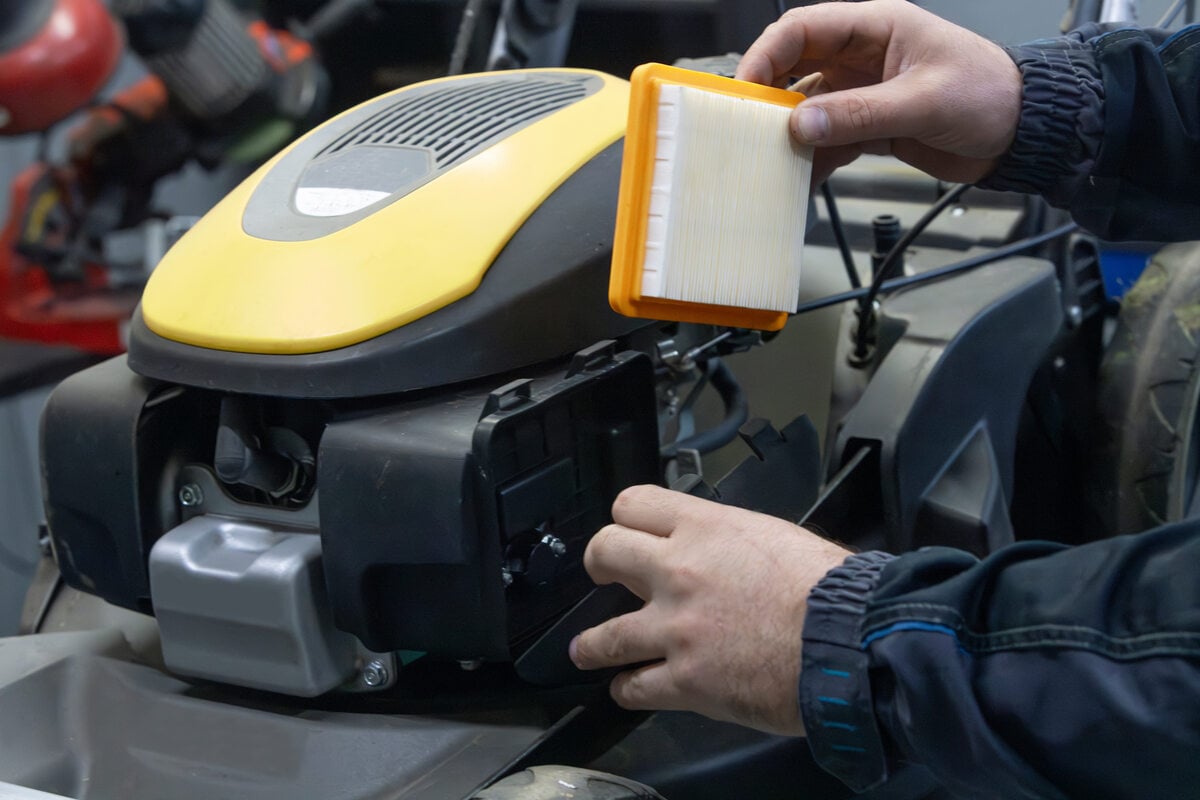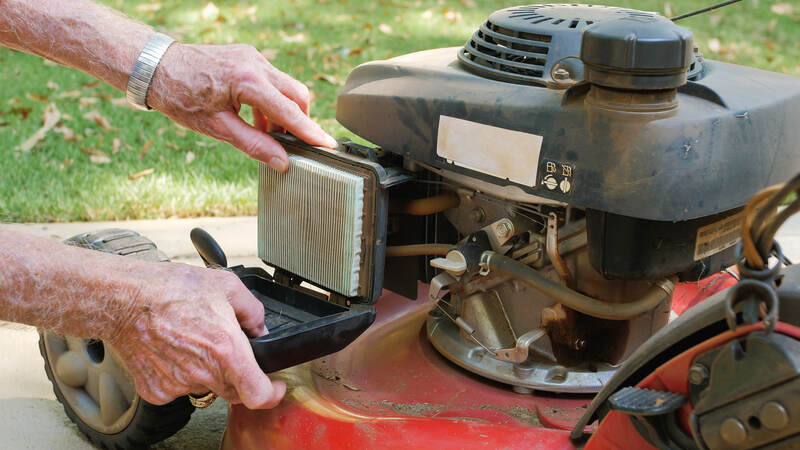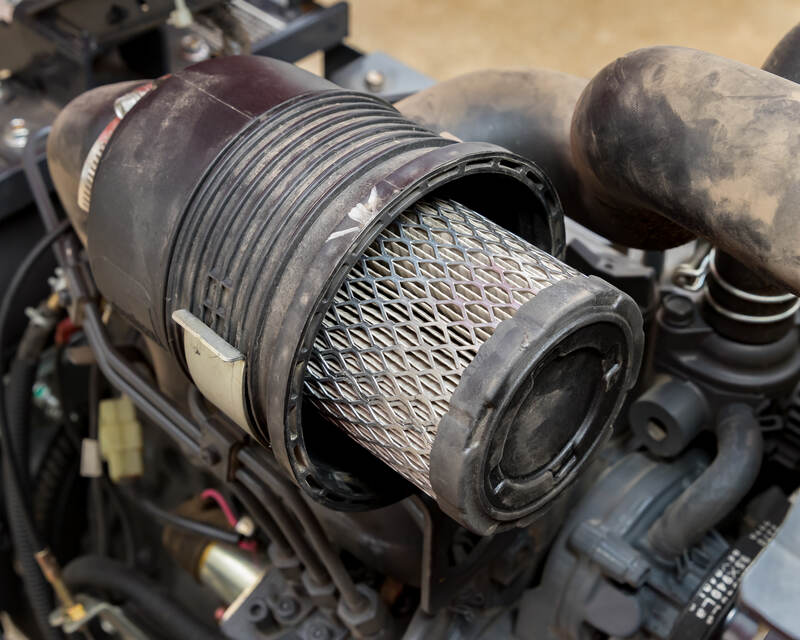
Basic maintenance goes a long way in maintaining a lawn mower. Knowing how to clean and change a lawn mower’s air filter will keep your mower in top condition, boost engine performance, and reduce long-term wear and tear.
Whether you’re a seasoned lawn care enthusiast or a first-time homeowner, this guide will walk you through what you need to know about maintaining your lawn mower’s air filter to keep your machine running smoothly all season long.
| Project Difficulty: Beginner Estimated Time to Complete: Less than 5 minutes (not counting drying time) Project Cost: Less than $20 for most filters (Riding mower air filters may cost more.) |
Why Maintaining Your Air Filter Matters
Maintaining your lawn mower’s air filter is essential for ensuring the engine runs efficiently and is debris-free. Here are some reasons why a clean air filter matters:
- Enables the engine to last longer and run cooler.
- Prevents dirt and debris from getting into the engine.
- Improves the mower’s performance by increasing fuel efficiency.
- Protects against damage to the engine’s internal components, which may result in expensive repairs.
Pro Tip: If lawn mower maintenance is something you’d rather leave to an expert, hire a local lawn care pro to mow your lawn and take mowing and maintenance off your to-do list.
Types of Lawn Mower Air Filters
There are three types of lawn mower air filters: paper, foam, and dual element filters (hybrid/combo). Check out the differences below:
| Type of Air Filter | How it Functions |
| Paper | • It traps dirt particles, filtering the air before it enters the engine’s combustion chamber. • This filter has pleated folds resembling an accordion. |
| Foam (Oiled or Dry) | • The oiled foam captures dirt and debris using motor oil spread throughout the foam. • Dry/not oiled foam catches only the biggest particles. |
| Dual Element (Paper & Foam) | • The foam element around the outside acts as a pre-cleaner for the paper element inside. • Air flows through two different filtering mediums, ensuring that only clean air reaches the engine. |
Tools You’ll Need
Having the right tools for the job ensures it goes smoothly and efficiently. Changing an air filter for your lawnmower is no different. Below is a list of tools to get you mowing sooner:
- Screwdriver: You may need a screwdriver to remove screws that secure the air filter housing, depending on the type of mower you have.
- Air compressor: If you have a paper air filter, you can use it to remove loose debris and grime.
- A couple of clean rags: You can clean the housing and dry off a foam air filter.
- Replacement air filter: If you intend to change the air filter, have a replacement air filter on hand. Check that it is the correct filter for your mower’s make and model.
- Gentle soap and water: These will be used to clean foam filters.
- Two plastic containers/tubs: The tubs will hold clean and soapy water.
- Small bottle of engine oil: This is needed to coat the foam air filter once it’s washed and dried off.
- Gallon-sized clear plastic baggie: The foam air filter goes in the baggie with the engine oil to coat the foam without making a mess.
- Owner’s manual: This isn’t technically a tool, yet it’s priceless. The owner’s manual for your mower contains detailed instructions, suggestions for maintaining the air filter, and other important information about upkeep.
Step-by-Step Guide to Cleaning a Lawn Mower Air Filter

Whether your mower has a paper, foam, or dual element (hybrid with foam and paper) air filter, the steps outlined below ensure that your lawn mower is prepared for its next mowing session.
1. Take Safety Precautions
Safety should always be your priority. Avoid changing the air filter while the lawn mower is still operating.
- Turn off the lawn mower engine and let it cool down.
- Disconnect the spark plug wire.
- Now, it’s safe to locate the air filter.
2. Locate the Air Filter
The air filter is protected by the housing/cover, typically positioned near the engine. If the cover has screws, you’ll need your screwdriver. However, you can snap it open by hand if it just has a clip.
Pro Tip: Before removing the filter, note how it is positioned. My co-worker Amanda, who maintains her Honda lawn mower, suggests you take a picture with your phone before removing it so you can put it back in the same direction.
3. Remove the Air Filter
With the cover removed, the next step is to remove the filter and identify its type (paper, foam, or dual element/hybrid). This is also a good opportunity to check how dirty it is and decide whether cleaning can salvage it.
4. Clean the Filter
Each filter type needs a specific cleaning method. We’ll start with paper, move on to foam, and wrap up with the dual-element filter.
How to Clean a Paper Filter
Cleaning a paper air filter couldn’t be simpler. Here’s how:
- Tap it gently against a hard surface (like a driveway) with the folds facing upwards to dislodge loose dirt.
- Optional: Then blow away any remaining particles using compressed air in short bursts, keeping the pressure below 30 PSI. Consult the manufacturer’s guidelines to see if using compressed air is recommended. This method can damage or tear the filter, causing costly damage to the engine. So use caution if you choose to go this route.
Check out some of Amanda’s tips for cleaning the paper air filter for her Honda lawn mower:
- Keep your mouth closed when banging a filter to clean it, as she’s sucked in a mouthful of dust many times.
- She said that her air filter is super easy to clean. She pushes down on the cover’s tabs and swings it open, pulling the filter out. She then knocks it on the driveway (folds/pleats facing up) several times or uses her air compressor to blow it out.
- She mentioned that her air filter gets dirty from dust since there’s a desert beyond her backyard in Idaho (think sagebrush and wide open spaces, not sand and cacti).
How to Clean a Foam Air Filter
Cleaning a foam air filter is easy. It should be washed in warm, soapy water and dried.
Here are the steps for how to clean a foam air filter:
- Grab two plastic containers/tubs.
- Fill one container with hot, soapy water, and the other with hot, clean water.
- Take your foam air filter, agitate it, and squeeze it in hot, soapy water until the dirt washes off.
- Squeeze it again to remove any excess water.
- Dunk it in clean, hot water to remove any dirt. Again, squeeze it a couple of times in the hot, clean water.
- Remove and squeeze a couple more times to get any excess water off.
- Dry it with your clean work cloth.
- Set it out to dry thoroughly.
How to Oil Your Foam Air Filter:
If your lawn mower uses oil on the foam air filter, here’s the process for coating the foam:
- Put a capful of engine oil and the foam air filter into the clear plastic baggie.
- Squish the foam around to coat it evenly with the oil.
- Once coated, remove the sponge from the bag and check to make sure there are no excess drips of oil.
- Dab it slightly with a paper towel to remove any excess.
- Reattach it to the mower.
How to Clean a Dual Element/Hybrid Filter
If you have a dual element air filter, you essentially have two air filters in one: the foam and the paper filter (the foam surrounds the paper filter). You can follow the steps above to clean the paper and oiled foam air filters. But if the outer foam filter has any holes or tears, replace it.
This video demonstrates how to clean a dual element filter on a pressure washer, but the process is exactly the same for lawn mowers:
5. Clean Filter Housing
Earlier in the process, you removed the filter housing/cover to access the air filter. Now’s a good time to examine the housing for dirt and debris and clean it up. To clean the housing, wipe it with a dry cloth to remove any accumulated dirt or debris.
6. Reinstall the Clean Air Filter or Install a New One
It’s now time to place the clean or new air filter into the housing.
Check the filter to see if any arrows help guide you with the proper placement. If you don’t see any arrows, refer to the photo you snapped with your phone for the original placement.
7. Reconnect the Spark Plug Wire
Then, reconnect the spark plug wire and fire up your mower’s engine. Allow it to run for a few minutes, listening for unusual sounds or vibrations. If everything seems in order, your mower is ready to use.
How Often Should You Clean or Replace Your Lawn Mower Air Filter?

Amanda mentions that her owner’s manual suggests cleaning the paper air filter every 25 hours and replacing it after 150 hours.
Since she mows for about 25 to 30 hours each season, she only needs to clean it once a year and can replace it every 5 to 6 years.
Check out the cleaning and/or replacement approach for the different air filters:
- Paper: Clean it every 25 hours or when you notice your filter is filled with dirt and debris or starts to turn brown. Check your manual for how often they recommend replacing it under normal conditions. However, if you mow in dusty conditions, you might need to clean or replace your air filter more often. If dirt remains trapped after a good cleaning, replace it.
- Foam: Replace your foam filter after 25 hours of use or every 3 months (whichever comes first). Regarding cleaning, a general guideline is to wash it at least once per mowing season, usually about halfway through. However, if you can’t remember the last time you cleaned it or notice dirt and debris stuck to the filter, it’s time.
- Dual element: Replace the pre-cleaner (foam that wraps the paper filter on the outside) every 25 hours or at the start of each season. When you do this, also clean the paper cartridge. Change the paper cartridge every 100 hours.
Note: These are general guidelines. Always refer to the manufacturer’s instructions for your lawn mower.
Troubleshooting Air Filter Problems
Regular upkeep is essential for minimizing issues with air filters. Several signs can indicate it’s time to clean or replace your air filter:
- Mower won’t start
- Decreased performance
- Smoky exhaust
- Decrease in mower’s cutting power
- Increased fuel consumption
- Engine overheating
- Visible dirt accumulation on the air filter
FAQ
No, the air filter is an essential component of the lawn mower that protects the engine. Operating without an air filter allows dirt and debris to enter the engine, causing damage and reducing performance.
Yes, but consult your owner’s manual first. If the owner’s manual allows it, compressed air can effectively dislodge dirt and debris trapped between the pleats. As a general rule, keep the air pressure under 30 PSI.
Absolutely. A clean air filter ensures optimal airflow, improving fuel combustion efficiency and reducing fuel consumption.
Maintaining Your Air Filter Between Changes
There’s nothing more frustrating than discovering your lawn mower isn’t working when it’s time to cut the grass. But simple maintenance tasks like cleaning your air filter can prevent these frustrations.
Cleaning your air filter regularly can also enhance fuel efficiency and extend the mower’s lifespan. However, if you find yourself temporarily without a working lawn mower and need your grass cut, don’t hesitate to contact a lawn care professional.
Read More:
- DIY Lawn Mower Maintenance Guide
- How to Change the Oil in a Lawn Mower in 9 Steps
- How to Sharpen Lawn Mower Blades
- Best Ways to Clean a Lawn Mower Deck
- How to Winterize Your Lawn Mower
Sources:
- “Mower Maintenance.” University of Illinois Urbana-Champaign.
- “The 10 Steps of Lawn Mower Maintenance.” By Marcus Garner, urban regional extension agent. Alabama A&M & Auburn Universities Extension.
Main Image Credit: Milan Noga reco / Adobe Stock